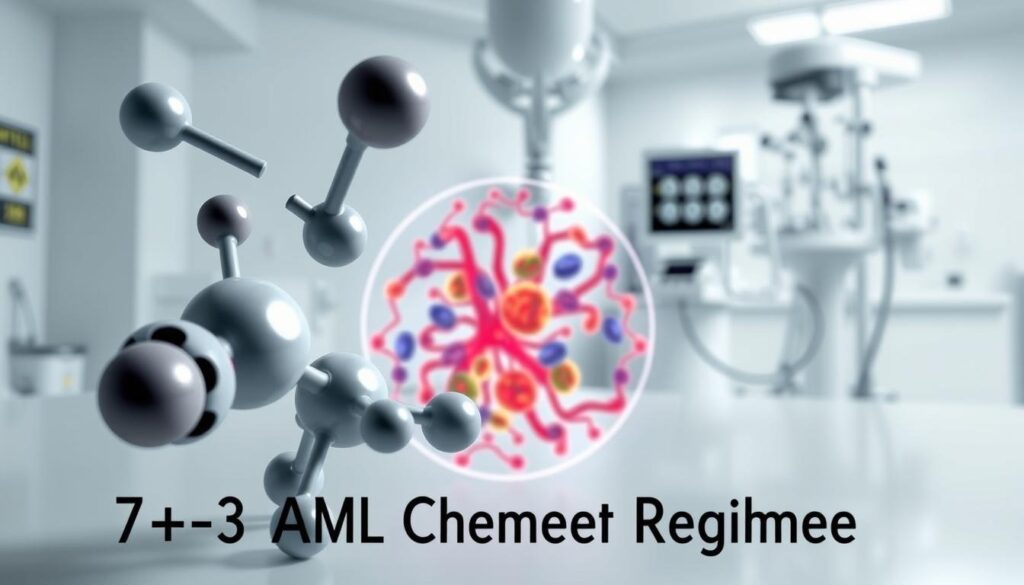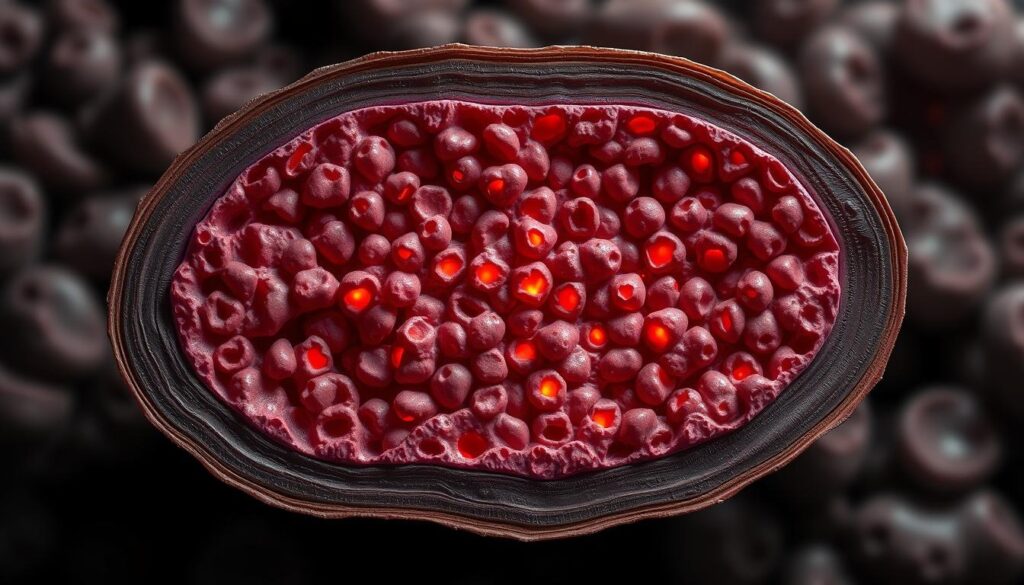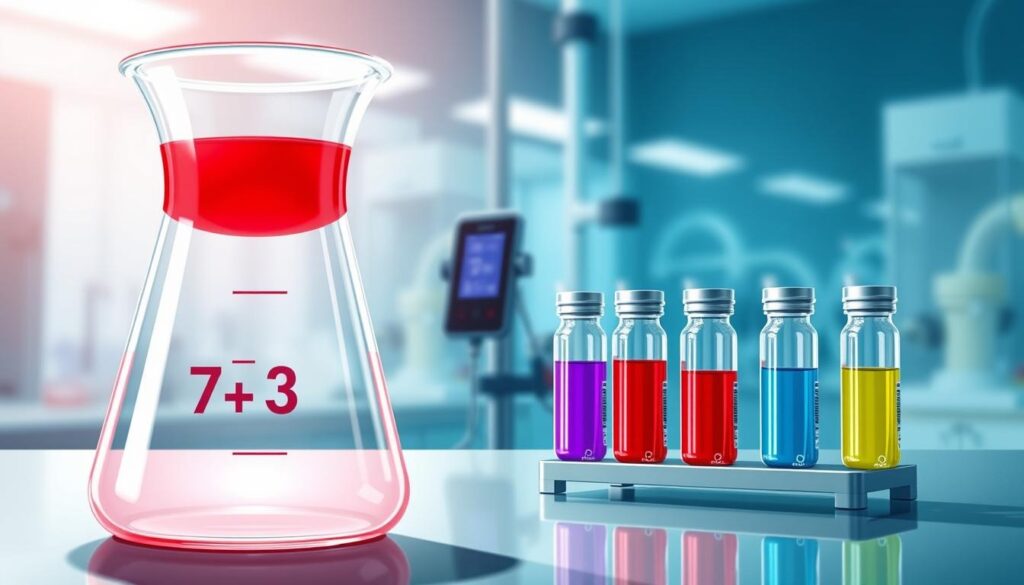Last Updated on October 21, 2025 by mcelik

At Liv Hospital, we know how hard it is to treat acute myeloid leukemia (AML). The 7+3 regimen is a key part of AML treatment. It uses cytarabine and an anthracycline to fight this tough disease.
As we move into 2025, AML treatment is getting better. Now, we use molecular profiling and targeted agents to make treatment more personal. At Liv Hospital, we mix these new ideas with the 7+3 regimen for the best care.
We know every patient’s fight with AML is different, so we tailor treatment to fit each person. By using the AML chemotherapy regimen, such as the 7+3 protocol and new targeted therapies, we aim to improve life quality and survival rates.

Acute Myeloid Leukemia (AML) is a serious blood cancer that needs quick action and treatment. It happens when abnormal cells grow in the bone marrow, stopping normal blood cell production.
AML is caused by genetic changes in blood cells. These changes make abnormal cells that don’t mature. These cells, called blasts, fill the bone marrow, stopping normal blood cell production.
The growth of AML involves genetics and environment. Genetic mutations are key in AML’s development, with some being more common.
Many things can increase your risk of getting AML. These include exposure to harmful chemicals, radiation, and past treatments. Age also plays a big role, with more cases in older people.
AML’s occurrence varies worldwide, with more cases in Western countries. In the U.S., AML is a big part of new leukemia cases.
Quick treatment is vital for AML because it’s aggressive. Without treatment, AML can cause serious problems like infections, bleeding, and organ failure.
Timely intervention with the right chemotherapy, like the 7+3 AML protocol, can greatly improve AML patient outcomes. We’ll explore this treatment further in later sections.

The 7+3 regimen is a key part of AML treatment. It combines different drugs to fight Acute Myeloid Leukemia (AML). This mix has been used for decades.
The 7+3 regimen is named for its structure. It includes 7 days of cytarabine and 3 days of an anthracycline. Cytarabine stops DNA from being made, while anthracyclines stop DNA from being copied.
This mix works well because it attacks AML cells in different ways. This makes the treatment more effective.
Cytarabine gets into DNA and stops it from being copied. This is great for stopping fast-growing cells like leukemia.
Anthracyclines, like daunorubicin or idarubicin, stop DNA from being copied. They also make leukemia cells die. This helps reduce the number of leukemia cells.
Here’s how cytarabine and anthracyclines work together in the 7+3 regimen:
| Component | Mechanism of Action | Effect on AML Cells |
| Cytarabine | Inhibits DNA polymerase | Halts DNA replication |
| Anthracyclines | Intercalates DNA, inhibits topoisomerase II | Induces apoptosis |
The 7+3 regimen is very effective against AML. It’s a strong treatment that can help many patients get better.
AML treatment often includes the 7+3 induction therapy protocol. This treatment needs careful handling and watching. We aim to help you understand this process.
The 7+3 regimen uses Cytarabine for 7 days and an Anthracycline for 3 days. This is the main part of AML treatment.
The dosing schedule is as follows:
| Drug | Dosage | Duration |
| Cytarabine | 100-200 mg/m² | 7 days |
| Anthracycline | Variable | 3 days |
7+3 induction therapy is given in a hospital setting. This is because the treatment is intense and needs close watching. Hospitals can quickly help if problems come up.
Being in the hospital is key for handling side effects like low white blood cell counts, infections, and bleeding.
How well the treatment works is checked with a bone marrow biopsy and aspirate after recovery. This is important for planning the next steps.
The timeline for checking how well the treatment worked is as follows:
| Assessment Time | Procedure |
| After the count recovery | Bone Marrow Biopsy and Aspirate |
| Post-induction | Evaluation of Remission Status |
Understanding 7+3 induction therapy helps us see the challenges of AML treatment. A well-planned treatment plan is very important.
We are seeing a big change in AML treatment thanks to molecular profiling. This advanced test helps doctors make better choices for their patients.
Molecular profiling has found key genetic markers in AML. These include mutations in FLT3, NPM1, and IDH1/2 genes. Knowing these genetic changes helps doctors pick the best treatment.
Molecular profiling helps doctors group AML patients by risk. This way, they can predict outcomes and tailor treatments better.
Molecular profiling changes how doctors choose treatments and predict outcomes for AML patients. It helps doctors pick the right therapies based on a patient’s leukemia genetics.
For example, some mutations make patients eligible for targeted therapies or clinical trials. This personalized approach is improving patient outcomes and giving new hope to those with tough genetic profiles.
As research keeps advancing, molecular profiling will become even more key in AML treatment. It could lead to better cure rates and quality of life for patients.
New treatments for AML have been developed. These treatments work with the 7+3 chemotherapy protocol. They are chosen based on the patient’s AML type, making treatment more personal.
About 30% of AML patients have FLT3 mutations. FLT3 inhibitors are key in treating this type of AML. Midostaurin and gilteritinib are examples of these inhibitors.
Midostaurin improves survival when added to the 7+3 regimen for FLT3-mutated AML. Gilteritinib is used for patients who have not responded to other treatments.
Hypomethylating agents like azacitidine and decitabine are important for AML treatment. They help by making genes work again that control cell growth and death.
Azacitidine with venetoclax helps older or unfit patients with AML. Decitabine is an alternative for those who can’t take azacitidine.
IDH inhibitors target mutant IDH1 and IDH2 enzymes in AML. Ivosidenib and enasidenib are approved for IDH1- and IDH2-mutated AML.
These targeted therapies offer hope for patients with specific AML types. They provide better and more tolerable treatment options. Using these agents with the 7+3 regimen is a big step forward in AML treatment.
Novel combination therapies are changing how we treat AML. We’re seeing new treatment options that improve patient outcomes and quality of life.
The azacitidine-venetoclax combo is showing great promise in AML treatment. This combo targets different AML pathways, leading to better treatment results. Studies show it boosts survival and response rates over traditional treatments.
The synergy between azacitidine and venetoclax offers a more effective AML treatment. Azacitidine makes cancer cells more vulnerable to venetoclax. This dual action tackles AML’s complexity, making it a valuable option.
Decitabine-cedazuridine plus venetoclax is another promising combo. This triplet regimen may improve response rates and survival in AML patients. Adding cedazuridine to decitabine boosts its effectiveness and allows for oral use, making treatment easier for patients.
Tablet-only regimens are a big step forward in AML treatment. Oral therapies reduce hospital stays and IV treatments, making treatment easier and less invasive for patients.
The move towards oral treatments like decitabine-cedazuridine plus venetoclax is a major advancement. As research advances, we’ll see more oral therapies that improve patient outcomes and quality of life.
Refractory Acute Myeloid Leukemia (AML) is a big challenge in blood cancer treatment. When standard treatments don’t work, we need new ways to help. AML that doesn’t respond to first treatments or comes back after remission is called refractory.
It’s important to understand why treatments don’t work and to look for new options. This includes trying different treatments and joining clinical trials. These steps can help improve how well patients do.
AML treatment resistance happens when leukemia cells don’t react to treatment or stop working soon. Relapse is when leukemia comes back after a break. Knowing the difference between not responding at first and coming back is key for choosing the next steps.
Salvage therapy is for when first treatments fail or after relapse. For AML that doesn’t respond, options might include:
These treatments aim to get the disease under control again. Choosing the right therapy depends on the patient’s health, past treatments, and genetic makeup.
Clinical trials offer new treatments for AML that doesn’t respond. We’re always looking for new ways to target specific genetic changes or resistance. Research focuses on:
Joining clinical trials can give patients access to new treatments. We suggest talking to a doctor about trial options for refractory AML.
In summary, treating refractory AML needs a detailed and tailored plan. We must look at the patient’s disease, past treatments, and health to decide the best treatment. By understanding resistance, using salvage therapies, and exploring trials, we can better help patients with this tough condition.
For many AML patients, bone marrow transplantation is a chance for a cure. This process replaces the sick bone marrow with a healthy one. It can come from the patient themselves or a donor.
Once, bone marrow transplants were only for young patients with a donor. But new techniques and care have opened doors for more. Now, older patients and those without a donor can also get transplants.
Key factors in determining eligibility include:
When to do a bone marrow transplant is very important. For many, it’s after they’ve reached first complete remission. But, for those with high-risk disease, it might be sooner.
| Disease Status | Transplant Timing | Considerations |
| First Complete Remission | After induction and consolidation | Standard risk patients |
| High-Risk Disease | As soon as possible | FLT3-ITD mutations, complex karyotype |
| Relapsed Disease | After re-induction therapy | Salvage chemotherapy followed by transplant |
Bone marrow transplantation can lead to long-term survival and even a cure for AML patients. Thanks to better selection, techniques, and care, outcomes have gotten better.
Long-term survival rates vary based on several factors, including:
In conclusion, bone marrow transplantation is a key cure for AML patients. As more people can get transplants and results keep getting better, more lives will be saved.
Managing chemotherapy side effects is key for AML patients. Chemotherapy is a main treatment for AML. It can cause many side effects, from immediate issues to long-term effects that affect life quality after treatment.
During the induction phase, patients face several acute issues. These include severe neutropenia, which raises infection risk, and thrombocytopenia, which increases bleeding risk. Supportive care measures, like growth factors to boost white blood cells and platelets, are vital to reduce these risks.
Close monitoring of blood counts and quick action for severe cytopenias are key during this phase.
AML survivors may face long-term and late effects from chemotherapy. These include cardiotoxicity, secondary malignancies, and endocrine issues. The risk of these complications highlights the need for long-term follow-up care, tailored to each patient’s treatment and risk factors.
Supportive care is essential in managing AML chemotherapy side effects. It includes medical management of acute and long-term issues, as well as psychological support and lifestyle guidance during and after treatment.
By taking a holistic approach to supportive care, healthcare providers can lessen chemotherapy’s adverse effects. This improves the treatment experience and outcomes for AML patients.
Our understanding of AML is growing, leading to better treatments for special groups. AML affects people of all ages and health levels. It’s clear we need treatments that fit each person’s needs, like for older or unfit patients, kids, and those with secondary AML.
Older AML patients face challenges due to health issues and less energy. New studies aim for treatments that are easier on the body but effective. For example, azacitidine and venetoclax together have shown good results, improving how well patients do and how long they live.
Key considerations for treating older or unfit patients include:
Pediatric AML is a big part of childhood cancers. New treatments aim to help kids more while keeping side effects low. These include strong chemotherapy and sometimes a bone marrow transplant for high-risk cases.
Notable advancements in pediatric AML treatment include:
Secondary AML comes from treatments like chemo or radiation. It’s harder to treat than AML that starts on its own. Scientists are working on new ways to target this type of AML.
Management strategies for secondary AML include:
By making treatments fit each person’s needs, we can make AML care better for everyone.
Acute Myeloid Leukemia (AML) treatment is always changing. This is thanks to new ways to understand the disease and better treatments. The 7+3 chemotherapy is a key part of treatment, but new agents are making it even better.
Molecular profiling helps doctors tailor treatments to each patient. This means treatments can be more effective. New drugs like FLT3 and IDH inhibitors are giving hope to those who didn’t respond well before.
The future of AML treatment looks bright. We’ll see even better treatments that are less harsh. Some patients are now in long-term remission, making the question of AML’s curability more pressing.
The focus on AML treatment is shifting to personalized care and research. We’re working hard to improve treatment options. Our goal is to give the best care to our patients and support them every step of the way.
Acute Myeloid Leukemia (AML) is a cancer that starts in the bone marrow. It quickly moves into the blood. It can also spread to other parts of the body, like the lymph nodes, liver, spleen, and central nervous system.
The 7+3 chemotherapy regimen is a common treatment for AML. It combines cytarabine for 7 days and an anthracycline for 3 days. This treatment aims to get the leukemia into remission.
Molecular profiling in AML finds specific genetic mutations in leukemia cells. This helps in planning treatment and predicting outcomes.
AML chemotherapy can cause nausea, vomiting, and fatigue. It can also lead to hair loss and a higher risk of infections. Doctors use supportive care to manage these side effects.
Yes, AML can be cured with the right treatment. The chance of a cure depends on the patient’s health, the leukemia’s genetic makeup, and how well they respond to treatment.
Refractory AML is when leukemia doesn’t respond to treatment or comes back after remission. Treatment options include salvage therapy and clinical trials.
Bone marrow transplantation is a cure for AML, mainly for those with high-risk disease or relapse. It replaces the diseased marrow with healthy marrow from the patient or a donor.
Yes, new treatments are being developed for AML. These include targeted therapies like FLT3 inhibitors and IDH inhibitors, as well as new combination regimens.
Older or unfit patients with AML often get less intensive treatments. This takes into account their health, other conditions, and what they prefer.
Clinical trials are key in AML treatment. They offer new therapies, mainly for those with refractory or relapsed disease. They help improve AML treatment.
Subscribe to our e-newsletter to stay informed about the latest innovations in the world of health and exclusive offers!
WhatsApp us